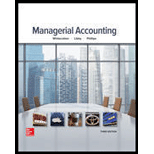
Concept explainers
(a)
Concept introduction:
FIFO:
FIFO is the method known as first in first out. In this method, the inventory is sold which is purchased first and the inventory purchased later adds in the closing inventory.
LIFO:
LIFO is the method known as last in first out. In this method, the inventory is sold which is purchased later and the inventory purchased earlier adds in the closing inventory.
The current ratio is computed by dividing the current assets by current liabilities. This helps in determining the liquidity of a company to pay liabilities.
The company that will report higher current ratio.
(b)
Concept introduction:
FIFO:
FIFO is the method known as first in first out. In this method, the inventory is sold which is purchased first and the inventory purchased later adds in the closing inventory.
LIFO:
LIFO is the method known as last in first out. In this method, the inventory is sold which is purchased later and the inventory purchased earlier adds in the closing inventory.
Debt to Assets Ratio:
The debt to asset ratio is computed by dividing the total debt by total assets. This ratio helps in knowing whether the company is financed through debt or equity.
The company that will report higher debt to assets ratio.
(c)
Concept introduction:
FIFO:
FIFO is the method known as first in first out. In this method, the inventory is sold which is purchased first and the inventory purchased later adds in the closing inventory.
LIFO:
LIFO is the method known as last in first out. In this method, the inventory is sold which is purchased later and the inventory purchased earlier adds in the closing inventory.
Earning per share:
The earning per share is the share of profit computed on the basis of number of shares held by the equity shareholder. It is computed by dividing the net profit by total number of shares issued.
The company that will report higher earnings per share.
Want to see the full answer?
Check out a sample textbook solution
Chapter 13 Solutions
Managerial Accounting
- Can you explain the process for solving this financial accounting problem using valid standards?arrow_forwardPQJ Company uses a job order costing system and has set a pre-determined overhead rate of 430% of direct labor cost. Job T-350 was charged with direct materials of $68,000 and with overhead of $77,400. Assume PQJ Company prices its jobs at 70% above manufacturing cost. Calculate the price charged to the customer for Job T-350.arrow_forward5 POINTarrow_forward
- I need help with this general accounting question using the proper accounting approach.arrow_forwardI need help with this general accounting question using the proper accounting approach.arrow_forwardPlease given correct answer for General accounting question I need step by step explanationarrow_forward
- Felix Manufacturing, a producer of electronic components, purchases semiconductor materials on credit on March 5. It processes these materials to make circuit boards on March 12 and pays cash for the semiconductor materials on March 20. On April 8, it sells the circuit boards to an electronics retailer, and on April 25, it receives a cash payment for this sale. What is the length of the cash cycle in this case?arrow_forwardI want to this question answer for General accounting question not need ai solutionarrow_forwardCan you explain the correct methodology to solve this general accounting problem?arrow_forward
- Upon completing an aging analysis of accounts receivable, the accountant for Riverside Manufacturing estimated that $8,600 of the $124,000 accounts receivable balance would be uncollectible. The allowance for doubtful accounts had a $740 debit balance at year-end prior to adjustment. How much is the bad debt expense? a. $740 b.$7,860 c. $9,340 d. $8,600arrow_forwardI need help finding the accurate solution to this general accounting problem with valid methods.arrow_forwardCan you explain the correct approach to solve this general accounting question?arrow_forward
 Cornerstones of Financial AccountingAccountingISBN:9781337690881Author:Jay Rich, Jeff JonesPublisher:Cengage Learning
Cornerstones of Financial AccountingAccountingISBN:9781337690881Author:Jay Rich, Jeff JonesPublisher:Cengage Learning College Accounting, Chapters 1-27AccountingISBN:9781337794756Author:HEINTZ, James A.Publisher:Cengage Learning,
College Accounting, Chapters 1-27AccountingISBN:9781337794756Author:HEINTZ, James A.Publisher:Cengage Learning, Financial Accounting: The Impact on Decision Make...AccountingISBN:9781305654174Author:Gary A. Porter, Curtis L. NortonPublisher:Cengage Learning
Financial Accounting: The Impact on Decision Make...AccountingISBN:9781305654174Author:Gary A. Porter, Curtis L. NortonPublisher:Cengage Learning Financial Reporting, Financial Statement Analysis...FinanceISBN:9781285190907Author:James M. Wahlen, Stephen P. Baginski, Mark BradshawPublisher:Cengage Learning
Financial Reporting, Financial Statement Analysis...FinanceISBN:9781285190907Author:James M. Wahlen, Stephen P. Baginski, Mark BradshawPublisher:Cengage Learning



